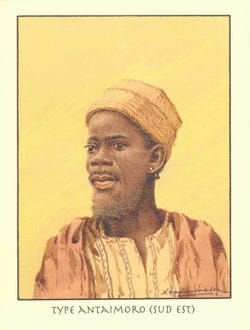The Antaimoro (or Antemoro or Antimorona)-"those of the rivage"-are a people of Madagascar who live mainly in the southeast of the island, extending from the district of Manakara to the district of Mananjary in the Province of Fianarantsoa, in the Vatovavy-Fitovinany region.
Vaγimba – “those of the forest” in proto-Barito of the South-East (ancient Austronesian language spoken in particular in Borneo).
At the very beginning of the settlement called “paleomalgacic period”, the Ntaolo were subdivided, according to their choice of subsistence into two large groups: the Vazimba (from *ba/va-yimba-“those of the forest”, de * sing-“Forest” in proto Southeast Barito (SEB), today barimba or orang rimba in Malay) who settled -as their name suggests- in the forests of the interior and the Vezo (from *ba/va/be /ve-jau, “those of the coast” in proto-Malayo-Javanese, today veju in bugis and bejau in Malay, bajo in Javanese) who remained on the West Coast.
The qualifier Vazimba therefore originally designated the Ntaolo hunters and / or gatherers who decided to settle “in the forest”, especially in the forests of the central highlands of the big island and those of the east and south-east coast, while the Vezo were the Ntaolo fishermen who remained on the west and south coasts (probably the coasts of the first landing).
The Malagasy feudal period: birth of the great kingdoms (1600-1895)
From the end of the first millennium until around 1600, the Vazimba of the interior as well as the Vezo of the coasts welcomed new immigrants from the Middle East (Persians Shirazi, Omanite Arabs, Arabized Jews) and from the East (Gujarati Indians, Malays, Javanese , Bugis) or even Europeans (Portuguese) who integrated and acculturated to Vezo and Vazimba society, often by matrimonial alliance. Although in the minority, the cultural, political and technological contributions of these newcomers to the old world Vazimba and Vezo substantially modified their society and were at the origin of the great upheavals of the 16th century which would lead to the Malagasy feudal era.
Inland, the struggles for hegemony of the various Vazimba clans of the central highlands (which the other Vezo clans of the coasts called the Hova) led to the birth of the Merina, Betsileo, Bezanozano, Sihanaka ethnic groups and/or kingdoms. , Tsimihety and Bara.
On the coasts, the integration of new oriental, Middle Eastern and African immigrants gave birth to the ethnicities and/or kingdoms Antakarana, Boina, Menabe and Vezo (West Coast), Mahafaly and Antandroy (South), Antesaka, Antambahoaka, Antemoro, Antanala, Betsimisaraka (East Coast).
The birth of these great kingdoms “neo-Indigenous”/”neo-Vezo” essentially modified the political structure of the old world of the Ntaolo, but the great majority of the old categories remained intact within these new kingdoms: the common language, the customs, the traditions, the sacred, the economy, the art of the old remained largely preserved, with variations in form depending on the region.
The Antaimoro kingdoms
The Antaimoro settled on the southeast coast between the 13th and 16th centuries. They would have lived in the Iharana region before taking root further south.
There are several clans within the Antaimoro or Antemoro ethnic group: the Anteony who arrived first in Matitanana, Vohipeno; the Antalaotra, who arrived later but are renowned for their writing (Sorbian) and their knowledge of the art of divination and the stars, the most illustrious of whom were the Anakara who, according to tradition, came from Saudi Arabia, forced to flee the court of the Sultan of yesteryear because of their Jewish ancestry; and finally the Ampanabaka who represent the majority.
Unlike the other tribes of Madagascar, the Antemoro have always distinguished themselves for their diplomacy. Moreover, one of their worthy sons, Andriamahazonoro of the Anakara clan, having been a special adviser to King Andrianampoinimerina and then to his son Radama I, was part of the first Malagasy delegation to London, at the time of Queen Victoria.
Antaimoro, the first people of Madagascar
01/08/2020
0 comment



Comment (0)